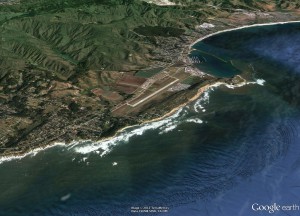
AIRPORT LAND USE COMMISSION
Background
With limited exceptions, an Airport Land Use Commission (ALUC) is required by California law in every county with an airport in its jurisdiction. Each ALUC must develop a plan for promoting and ensuring compatibility between each airport in the county and surrounding land uses. In San Mateo County, the C/CAG Board acts as the Airport Land Use Commission.
Purpose
The purpose of the Airport Land Use Commission is “to protect public health, safety, and welfare by ensuring the orderly expansion of airports and the adoption of land use measures that minimize the public’s exposure to excessive noise and safety hazards within areas around public airports to the extent that these areas are not already devoted to incompatible uses.”
Powers and Duties
The ALUC has three primary responsibilities: to coordinate airport land use compatibility planning efforts at the state, regional and local levels; to prepare and adopt an Airport Land Use Compatibility Plan (ALUCP) for each public-use airport in its jurisdiction; and, to review plans, regulations and other actions of local agencies and airport operators. In San Mateo County, C/CAG staff acts as the staff for the Airport Land Use Commission.
AIRPORT LAND USE COMPATIBILITY PLAN
Consistent with State law, the C/CAG Board, acting as the Airport Land Use Commission, has adopted ALUCPs for the three airports located within San Mateo County:
Airport Land Use Compatibility Plan (ALUCP) for the Environs of San Carlos Airport
Airport Land Use Compatibility Plan (ALUCP) for the Environs of Half Moon Bay Airport
 |
SFO Airport Influence Area B |
| California Airport Land Use Planning Handbook | |
 |
2004 sc airport influence a and b-map1 |
 |
2004 sc airport influence b-map2 |
Primary Areas of Concern
- Airport Noise Impact Reduction – To reduce the potential number of future airport area residents who could be exposed to noise impacts from airport and aircraft operations.
- Safety of People on the Ground and in Aircraft in Flight – To minimize the potential number of future residents and land use occupants exposed to hazards related to aircraft operations and accidents.
- Height Restrictions/Airspace Protection – To protect the navigable airspace around the airport for the safe and efficient operation of aircraft in flight.
- Overflight Notification – To establish an area within which aircraft flights to and from the airport occur frequently enough and at a low enough altitude to be noticeable by sensitive residents. Within this area, real estate disclosure notices are required, pursuant to State law.
Airport Influence Areas
Each ALUCP identifies an Airport Influence Area (AIA), which is further broken down into Area A, which requires real estate disclosure of the presence of the airport; and Area B, the project referral area, which requires new plans and projects to demonstrate consistency with the goals and policies of the ALUCP.
CONSISTENCY DETERMINATIONS – Local Jurisdiction Requirements
After adoption of an ALUCP revision or amendment, State law gives local jurisdictions 180 calendar days to amend their general plan, specific plans, zoning ordinances, and facilities master plans, as necessary, to be consistent with the amended ALUCP. The types of local actions subject to ALUC review depends on whether the local agency has amended its plans accordingly.
-
- Before a local agency makes plans consistent: All proposed development and land use policy actions that affect property within Area B of the AIA must be submitted to the Airport Land Use Commission for a consistency determination prior to agency action on any policy decision, and prior to issuance of any development permit.
- After a local agency makes plans consistent: Any proposed land use policy action (adoption or amendments to general plans, specific plans, zoning ordinances, and facilities master plans) within Area B of the AIA must be submitted to the ALUC for a consistency determination prior to agency action.
ALUCP Review Process
The airport/land use compatibility review process includes two hearing steps. The first step is review and recommendation by the Airport Land Use Committee, and the second step is review and final action by the C/CAG Board, acting as the Airport Land Use Commission.
(Note: Per State law, the Airport Land Use Commission must take final action on a request within 60-days of submittal of a “complete” application. Therefore, it is recommended that local agencies incorporate this review in their overall project review timelines to avoid unnecessary delays.)
- Step 1
- The local agency submits to C/CAG ALUC staff a completed Application for Land Use Consistency Determination , together with related materials outlined in the application.
- ALUC staff reviews the materials, coordinates the review with the local agency, and schedules the item for the next available Airport Land Use Committee meeting.
- ALUC staff drafts a staff report for Airport Land Use Committee, other agency and public review, analyzing the relevant airport land use compatibility issues and making a recommendation for Airport Land Use Committee action.
- The Airport Land Use Committee reviews the item at a public meeting, considers relevant public input, and takes action in the form of a recommendation to the Airport Land Use Commission (C/CAG Board) (ex. consistent, conditionally consistent or inconsistent with the relevant provisions in the ALUCP.
- Step 2
- The Airport Land Use Committee recommendation is forwarded to the C/CAG Board, acting as the Airport Land Use Commission, for consideration at its next available meeting.
- ALUC staff prepares a report for review by the Airport Land Use Commission (C/CAG Board) that describes the proposed action and includes the Airport Land Use Committee recommendation.
- The Airport Land Use Commission (C/CAG Board) reviews the materials and adopts a resolution declaring whether the proposal is consistent, conditionally consistent or inconsistent with the relevant provisions in the ALUCP.
- The local agency is formally notified, in writing, of the final action on the proposal.
